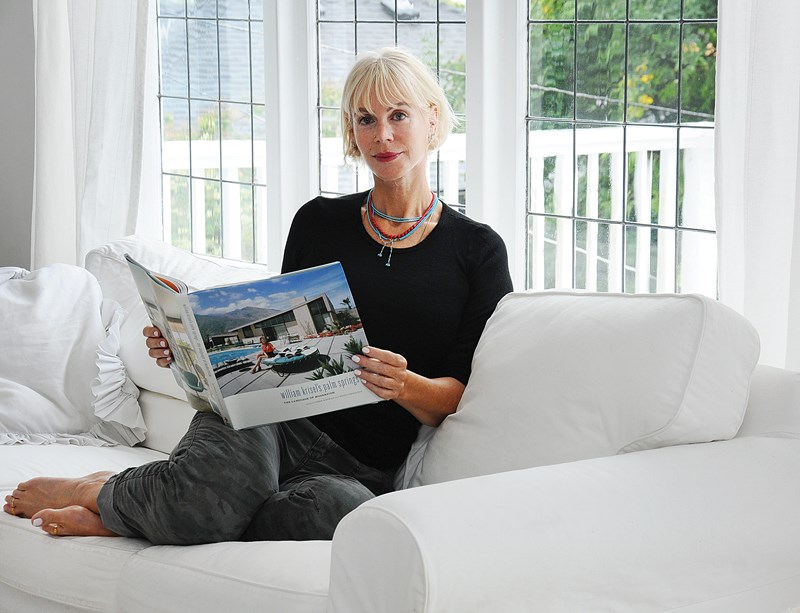Heidi Creighton knew she was home as soon as she laid eyes on the 1957 Model A-3 house designed by William Krisel.
“I didn’t even go inside. It was the one,” she says.
It was 2012 when Creighton purchased her restored 1,600-square-foot, flat-roofed house in the Twin Palms neighbourhood of Palm Springs. Although she has an extensive background in art history and architecture, at the time she wasn’t too familiar with the pioneer of California mid-century modernism behind her new abode.
“I knew a little bit about William Krisel’s work, but only on the periphery. He didn’t have the profile of (Richard) Neutra or (Donald) Wexler or some of the other big names in California modernism,” says Creighton, who lives in West Vancouver most of the year.
But her enthusiasm quickly grew. Now in his early 90s, Krisel is credited with designing more than 40,000 living units – from custom homes to mass-produced housing, and recreation facilities to shopping malls – over the course of his 60-year career. The prolific architect has been featured in print publications and documentary films, but Creighton says there were no books dedicated exclusively to his life and work. So, she partnered with her Palm Springs neighbour, Chris Menrad, who lives five doors down the street, also in a restored Krisel house, and they co-edited William Krisel’s Palm Springs: The Language of Modernism. The book launched in February during Modernism Week.
Krisel’s designs are scattered between Los Angeles, San Diego, Las Vegas, Palm Springs, Borrego Springs and elsewhere, but Creighton and Menrad decided to focus their research on his projects in the Coachella Valley. “Palm Springs has really become a mecca for mid-century modern architecture,” Creighton says.
William Krisel’s Palm Springs chronicles the work and architectural philosophy of the modernist through documents and drawings, sourced from both his personal collection and from the Getty Research Institute. There are also archival photographs, recent photographs, and written contributions from architectural scholars that explore Krisel’s lasting impact on mid-century design.
“Most of the research we have is primary because it comes from the archives and it hadn’t ever been explored in a book before,” Creighton says.
One of the most extraordinary things about Krisel, Creighton notes, was his ability to produce tract housing in the post-war period while maintaining his artistic integrity.
“Tract housing was not even considered architecture by a lot of architectural critics and architects themselves,” she explains.
Krisel, however, was able to meet developers’ budget, time and material constraints, while at the same time making would-be homeowners feel as though they were buying a unique residence. In Creighton’s Twin Palms neighbourhood, for example, there are 90 Krisel houses, but she says they don’t have the “cookie-cutter” appearance of most of the tract homes built in the 1950s.
“They’re basically all the same floor plan, but you don’t know this from the street because there were eight various elevations that buyers could choose from and he rotated the houses on the lots,” she says.
While Creighton’s Palm Springs house doesn’t have Krisel’s distinctive butterfly roof, it does feature his signature sun flaps, but they have been modified to let in more light (a modern-day option thanks to efficient air conditioning and triple-paned glass). Krisel himself recently redesigned Creighton’s yard to incorporate indigenous plants and swaths of blue and brown recycled rubber mulch.
“He doesn’t see landscaping as supportive of architecture. He sees them as kind of equal partners in the project.”
Creighton was born and raised in a subdivision of Don Mills, Ont., one of Canada’s first planned communities. She attributes her lifelong appreciation for the mid-century modern esthetic to her childhood neighbourhood, with its clean lines and simple home designs.
On the North Shore, there are many fine examples of West Coast modern homes, an architectural style Creighton says follows the same basic design principles as those used in Southern California during the post-modern period: modestly sized, open-concept, single storey structures with large windows that merge the indoor with the outdoor space.
The biggest difference, of course, is the environment into which the homes were built. West Coast modern houses tend to be situated on lush, green properties and favour wood as a building material. In Southern California, concrete was the preferred post-modern construction material and the surrounding landscape was far more sculptural, featuring rocks and cacti.
“In the desert you’ve got this extreme light, extreme temperatures, and up here you have I think a much softer, more subtle light.”
Despite weathering the harsh desert climate for six decades now, Creighton says Krisel’s houses still maintain a “fresh” quality, which is part of their lasting appeal.
“If you look at them now, they’re not dated,” she says.
William Krisel’s Palm Springs: The Language of Modernism, edited by Chris Menrad and Heidi Creighton (Gibbs Smith; Layton, Utah), $45 (U.S.). Available at select retailers and on Amazon.com.



